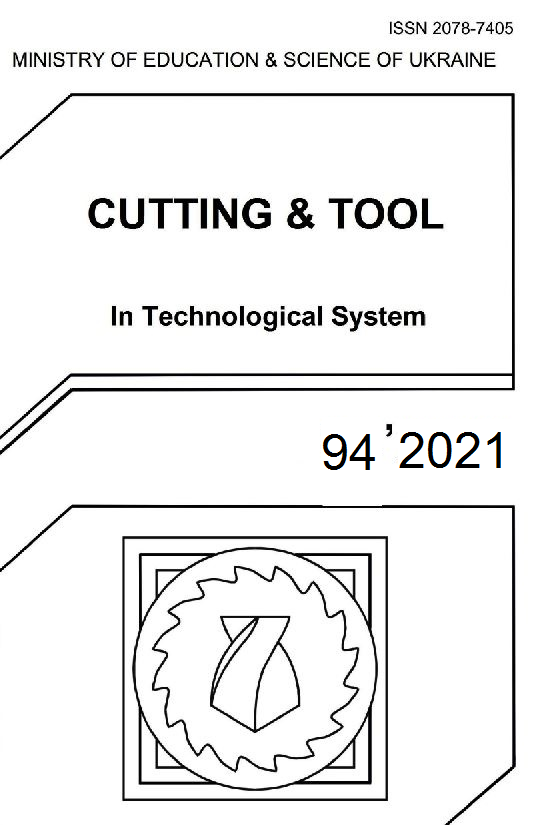INTERACTION OF THE ABRASIVE MEDIUM WITH THE TREATED SURFACE AND THE PROCESS OF METAL REMOVAL DURING VIBRATION TREATMENT IN THE PRESENCE OF A CHEMICALLY ACTIVE SOLUTION
DOI:
https://doi.org/10.20998/2078-7405.2021.94.05Keywords:
abrasive medium, types of medium action, surface layer, mechanical-physicochemical model, metal removal, chemically active solution, vibration treatment technologiesAbstract
Interaction of working medium granules with the processed surface of the part is considered. It is noted that the processing methods are characterized by the dynamic interaction of the abrasive medium with the processed surface. It is indicated that during vibration treatment there is an impact contact of the abrasive granule with the surface of the part, which leads to the formation of characteristic traces during the formation of the surface relief. The types of impact of abrasive grains of working medium granules on the surface of the processed part are identified. It is indicated that the effect of abrasive grains depends on the geometric parameters of the tops of the grains and the working contour of the granule as a whole. The alternation of the operation of abrasive grains in the connection with the nature of the motion of the granule over the surface of the part is shown. The interaction of surfaces of bodies during vibration treatment is considered. The distinctive features of the vibration treatment method from other analogs are indicated. The conditions for the formation of the surface layer of the part during vibration processing are given. The analysis of the mechanical-physicochemical model of the micro-cutting process in the presence of a chemically active solution is carried out and a comparison of the intensity of technologies for vibration treatment of steel parts is given.
References
Mitsyk A.V Rozvytok procesiv obrobky vil'nym abrazyvnym seredovyshhem v kolyvnyh rezervuarh i formuvannja i'h fizyko-tehnologichnyh mozhlyvostej. Visnyk SNU im. V. Dalja. Sjevjerodonec'k, SNU im. V. Dalja, 2020. № 4 (260). pp. 55 – 65. DOI: https://doi.org/10.33216/1998-7927-2020-260-4-55-65
Instrumental'noe obespechenie processov obrabotki detalej v granulirovannyh sredah: monografija / A.P. Babichev, P.D. Motrenko, S.A. Kostenkov, O.A. Rozhnenko, M.A. Tamarkin, V.Ja. Shumjacher; Donskoj gos. tehn. un-t. Rostov-n/D: 2011. 267 p.
Mitsyk A.V., Fedorovich V.O., Grabchenko A.I. Mehano-fizyko-himichne modeljuvannja procesu rujnuvannja poverhni detali u vil'nomu abrazyvnomu seredovyshhi. Rizannja ta instrumenty v tehnologichnyh systemah. Kharkiv, NTU «KhPI», 2020. № 92. pp. 62 – 67. DOI: http://doi.org/10.20998/2078–7405.2020.92.08
Babichev A.P. Osnovy vibracionnoj tehnologii / A.P. Babichev, I.A. Babichev. Rostov-n/D: Izdatel'skij centr DGTU, 2008. 694 p.
Babichev A.P. Vibracionnaja obrabotka detalej v abrazivnoj. M.: Mashinostroenie, 1968. 92 p. 6. Ob’emnaja vibracionnaja obrabotka / I.E. Burshtejn, V.V. Balickij, A.F. Duhovskij, M.Ja. Dubova i dr.; pod red. I.E. Burshtejna. Moskva: JeNIMS, 1977. 108 p.
Kartashov I.N. Obrabotka detalej svobodnymi abrazivami v vibrirujushhih rezervuarah / I.N. Kartashov, M.E. Shainskij, V.A. Vlasov. Kiev: Vishha shkola, 1975. 188 p.
Downloads
Published
Issue
Section
License
Copyright Notice
Authors who publish with this Collection agree to the following terms:
1. Authors retain copyright and grant the Collection right of first publication with the work simultaneously licensed under a Creative Commons Attribution License that allows others to share the work with an acknowledgement of the work's authorship and initial publication in this Collection.
2. Authors are able to enter into separate, additional contractual arrangements for the non-exclusive distribution of the Collection's published version of the work (e.g., post it to an institutional repository or publish it in a book), with an acknowledgement of its initial publication in this Collection.
3. Authors are permitted and encouraged to post their work online (e.g., in institutional repositories or on their website) prior to and during the submission process, as it can lead to productive exchanges, as well as earlier and greater citation of published work.

